Prague, Czech Republic (2006)
The Mystical Medieval Central European Gem Of Cobbled Streets, Riverside Parks & Stunningly Wonderful Architecture
Prague, Czech Republic. March 8, 2006
It was yet another early start today. Shortly after 7 a.m. this morning I found myself sitting at the base of the Jan Hus statue in the centre of Staromestské námestí, otherwise known as Old Town Square, in Prague, Czech Republic. It was a cold but gloriously crisp morning. There wasn’t a cloud in the sky & at that time there weren’t too many souls sharing Prague’s famous Old Town Square with me – I felt like I had one of the most historic & idyllic civic spaces in the whole of Europe all to myself.
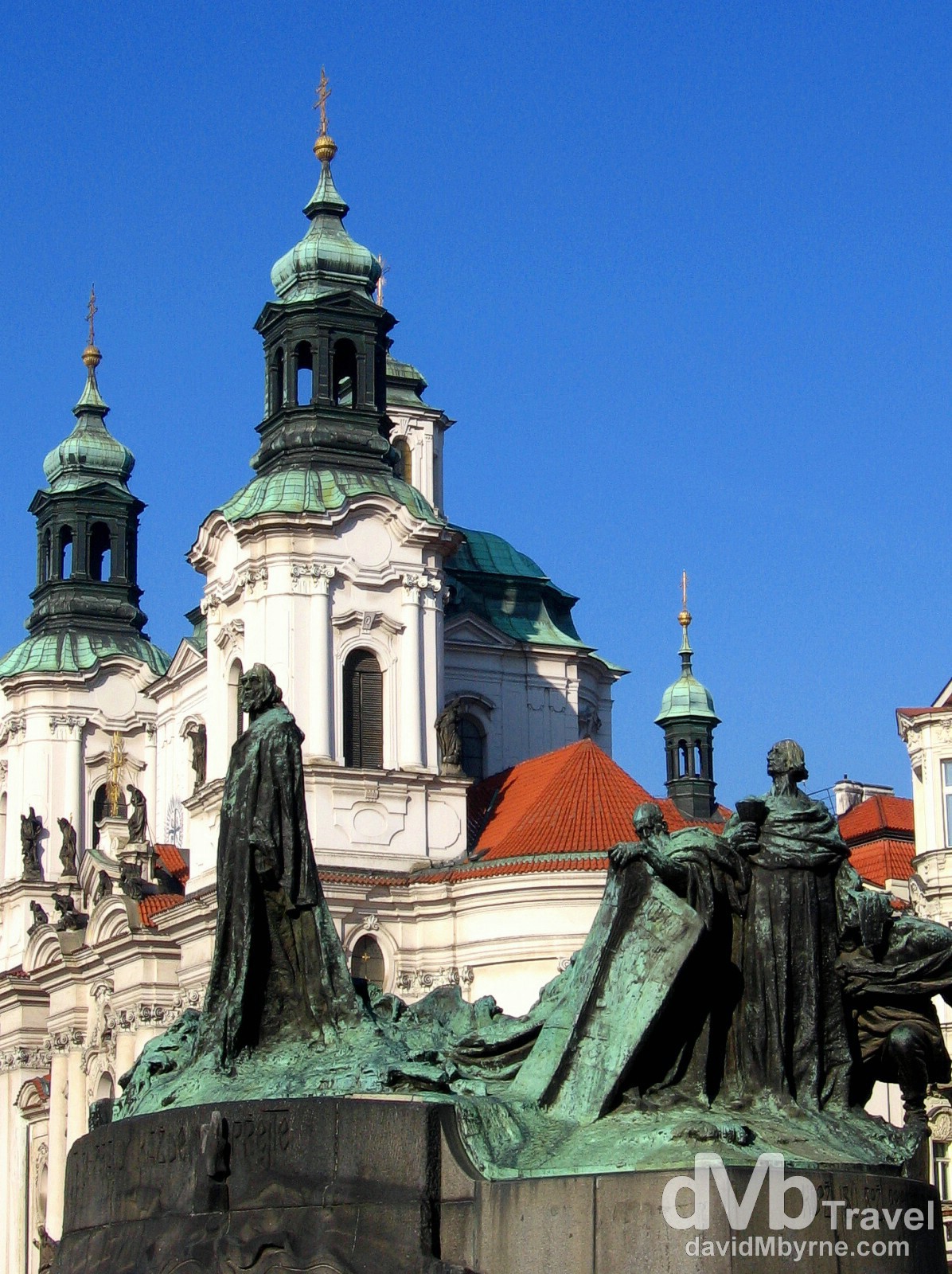
In the center of Prague’s Old Town Square is a statue of Jan Hus, a Czech religious thinker, philosopher and reformer. The Roman Catholic Church considered his teachings heretical and had him burned at the stake in 1415. In 1999, a mere 5 centuries after his death, the church apologized for the execution. Whoops. The statue was erected on July 6, 1915, to mark the 500th anniversary of his death. In the background is the Baroque Saint Nicholas’ Church, just one of the city’s many churches. Old Town Square, Prague (![]() ), Czech Republic. March 8, 2006
), Czech Republic. March 8, 2006
Doubtless I’d have found myself sitting in Prague’s Old Town Square as early as I was this morning if not for the fact that I hadn’t long since disembarked the overnight train from Krakow, Poland. I was tired & could have done with freshening up but with one day at my disposal to get reacquainted with Prague, the golden, mystical medieval Central European gem of stunningly wonderful architecture, I was set & ready for a whole day of traipsing the cobbled streets of what is probably Europe’s most fairy tale-esque city & certainly one of its best preserved.
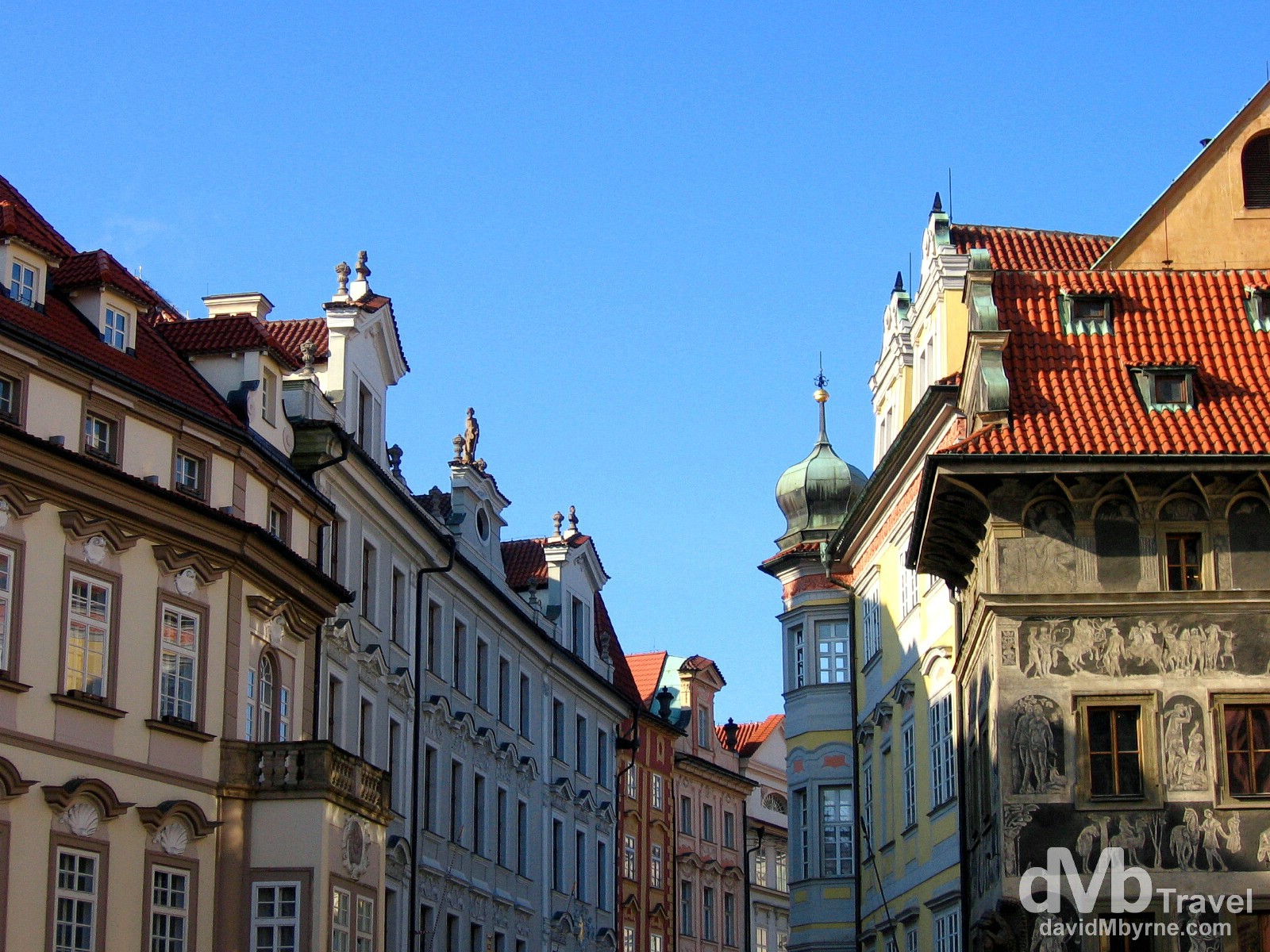
Prague, especially its Old Town area east of the city’s Vltava River, is a smorgasbord of stunning architecture – Gothic, Renaissance, Baroque, Art Nouveau, neoclassical & cubist. It’s all on display here and it all looks great. Prague is impeccably preserved, so well preserved (& presented) in fact that one could be forgiven for thinking the whole city has recently received a huge facelift. It hasn’t & a large part of the reason for the city’s remarkable present-day condition is the fact that it escaped World War II virtually unscathed (& as a UNESCO protected site, about the only damage the city is likely to suffer these days is from the hordes of tourists who tramp around its streets each year). This is a picture of building facades one of the many streets just off of Old Town Square. Old Town, Prague, Czech Republic. March 8, 2006.
-UNESCO commenting on the Historic Centre of Prague
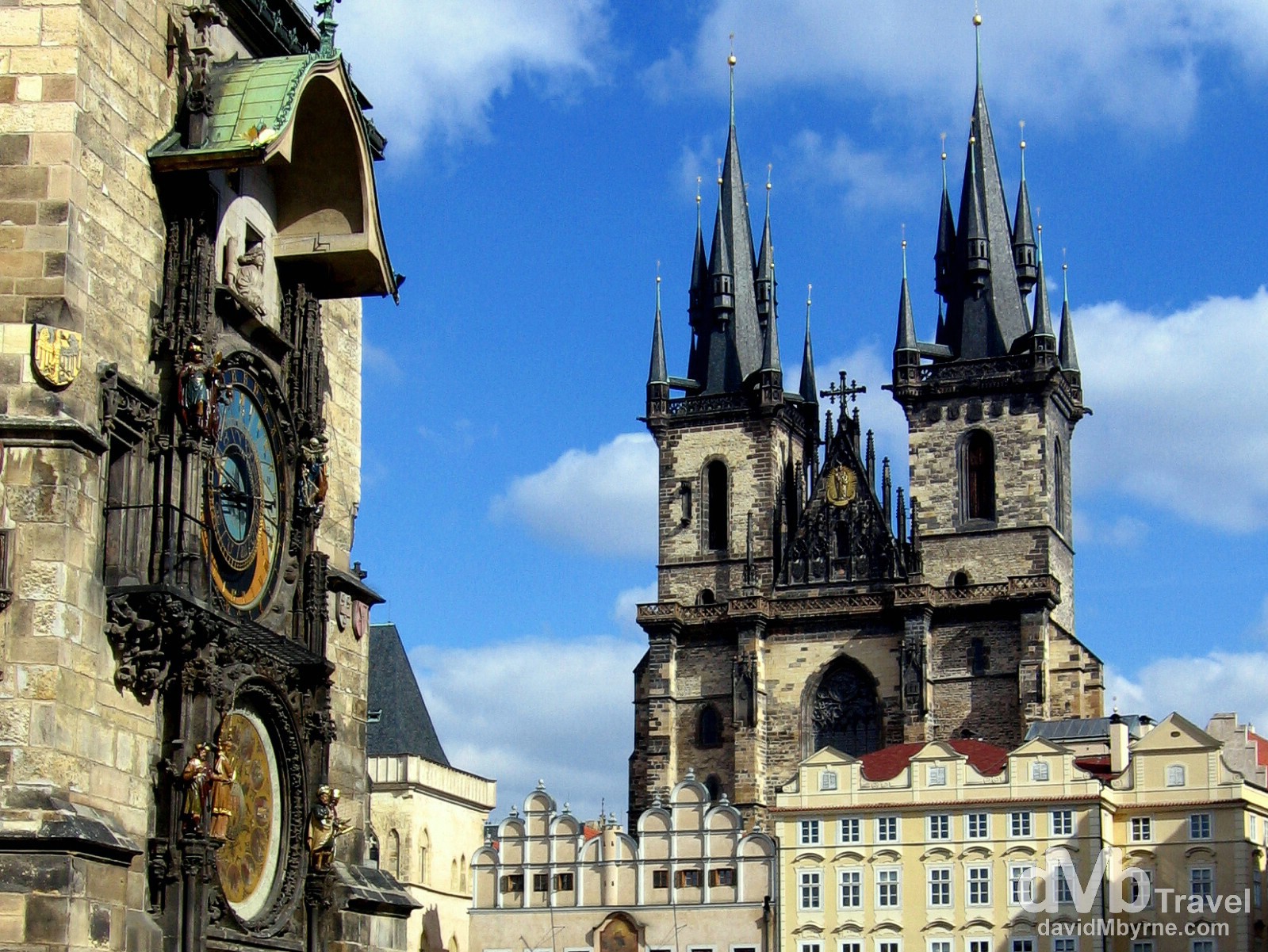
This a picture looking east across Old Town square at the massive Týn Church. The Gothic behemoth is the dominant feature of the Old Town and since the 14th century has been the main church of this part of the city. The towers seen here are 80 metres high and are topped by four small spires. Another feature of the Old Town Square seen here is the famous medieval Astronomical Clock of the Old Town Hall clock tower. The clock attracts quite a gathering of admirers on the hour, every hour, to witness its parade of apostles and other figures, including a bell ringing skeleton (honest). I was almost alone when viewing the 9 a.m. display of what can only be described as Prague’s most bemusing spectacle, a far cry from the scrum I was part of when trying to view the display on my previous visit to the city back in August 1999. The clock itself is comprised of three parts, the oldest of which is the ‘Astronomical Dial’ (middle). Dated from 1410, it represents the position of the Sun and Moon in the sky and displays various astronomical details. ‘The Walk of the Apostles’ section (top) sees the four figures flanking the clock set in motion, with Death, represented by the skeleton, striking the time. All 12 statues of the Apostles are present at noon, the only time they all make an appearance. The final section is the ‘Calendar’ dial (bottom) with medallions representing the 12 months. Old Town Square, Prague, Czech Republic. March 8, 2006.
Oh what a city. Sitting slap bang in the centre of mainland Europe, the historic centre of Prague, the capital of the Czech Republic, has a unique charm that draws tons and tons (and tons) of tourists each year. Inscribed on the UNESCO list of World Heritage Protected Sites in 1992, guidebooks wax lyrical about its magic. They have done so for decades but especially since January 1, 1993, when the old Czechoslovakia ceased to exist and it split into present day Slovakia (to the east) and the Czech Republic. It’s my second time in the city, having first visited back in August 1999. That was a different trip, more of an absinthe (ab-SIN-the) & hangover kind of trip – Prague is a great place to party. The city still left an impression me back then & I’ve always wanted to return. Seven years on and the city is still equally beautiful, not quite as cheap as I remember it being, & a whole lot busier than I remember it being. Yes, make no mistake –above all the fairytale scenes it presents, Prague is, unfortunately, a bit of a tourist trap. An astonishingly beautiful tourist trap but a tourist trap nonetheless. (UPDATE – March 2014 || And it hasn’t gotten any better. In fact, Prague is now overrun, so says I on my third visit to the city. Check out that entry for more of the same from Prague).
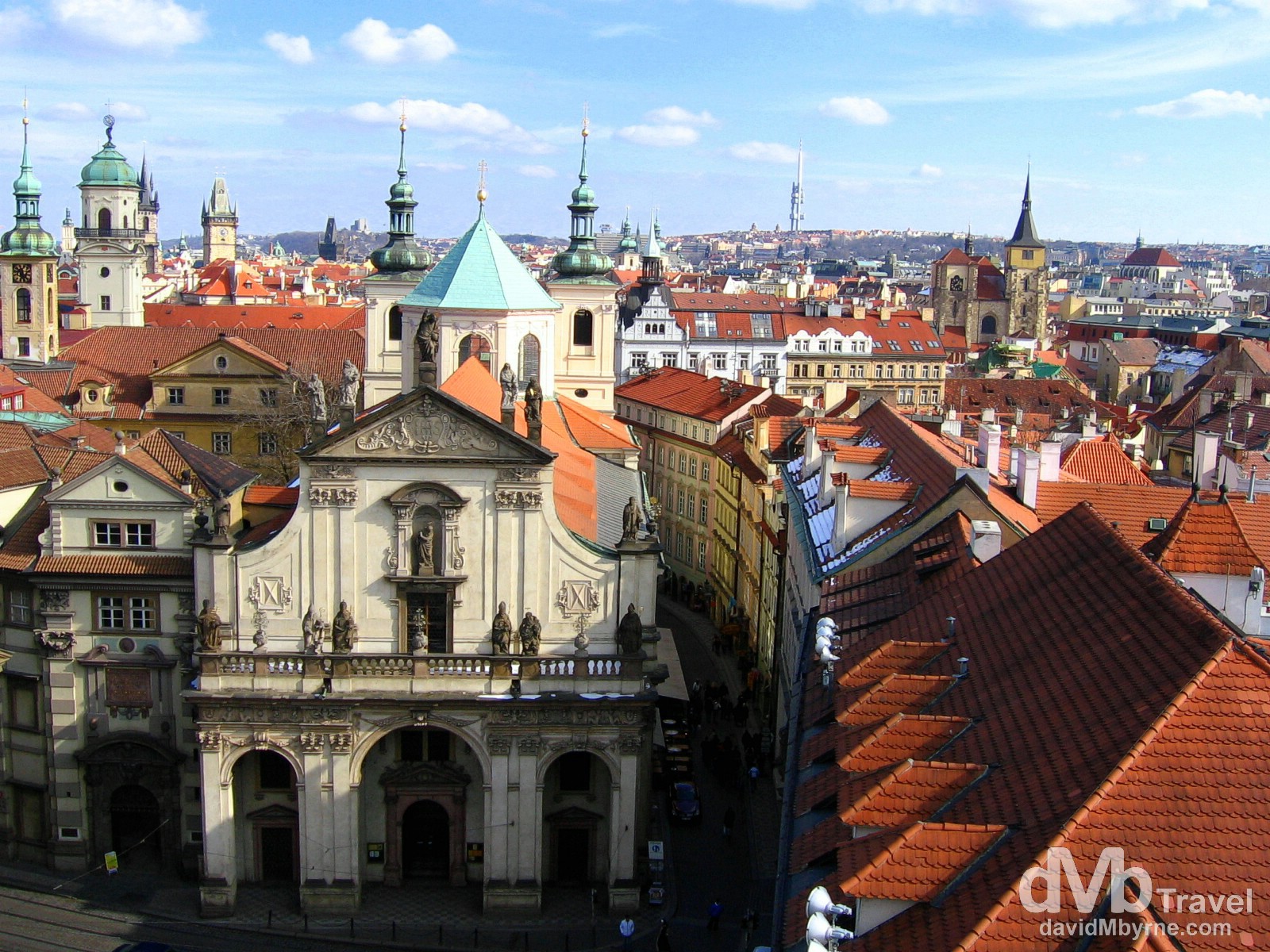
A picture of the rooftops of the Old Town looking from the Old Town Tower of Charles Bridge. I spent a bit of time taking in the tower’s exhibits detailing the history of the tower itself, often considered to be one of the most astonishing civil Gothic-style buildings in the world. But to me it was all about the views the tower afforded, views of the Old Town to the east (seen here) and the Charles Bridge and castle district to the west (see next picture). Rooftops of the Old Town of Prague as seen from the Old Town Tower of Charles Bridge, Prague, Czech Republic. March 8, 2006.
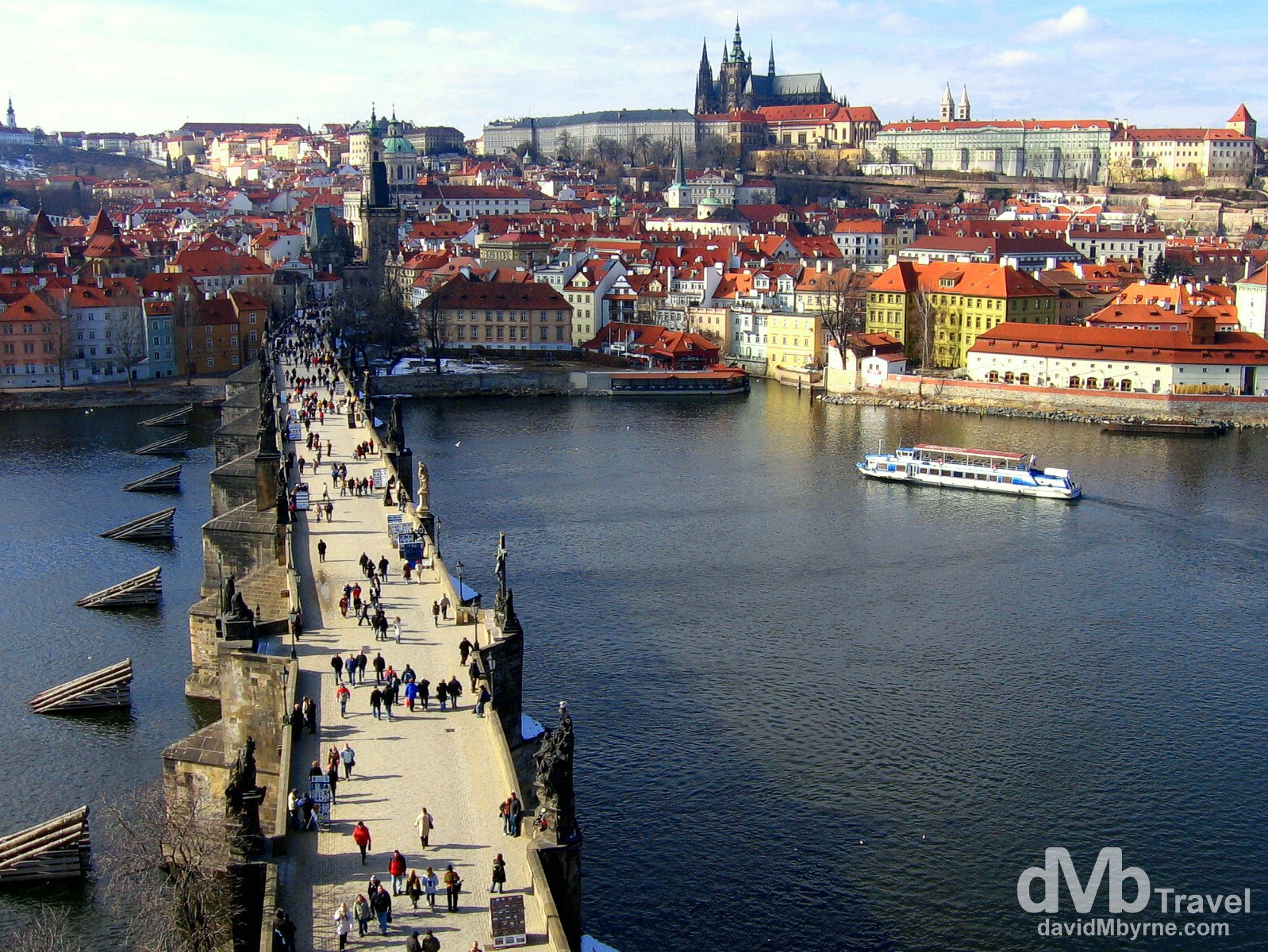
Prague’s two best know areas are the medieval castle district (in the distance) and the Old Town area. They are separated by the Vltava River which is crossed by Karluv most, Charles Bridge, seen here from the Old Town tower of the bridge. The 516-meter long, 10-metre wide bridge, built in 1357 under the auspices of King Charles IV, was, until 1841, the city’s only bridge. This solid-land connection made Prague important as a trade route between east and western Europe. In a city of numerous sights this is probably Prague’s most famous and everyone eventually gravitates towards it. A quiet witness of medieval times at night, the bridge comes alive during daylight hours, even outside the peak summer tourist season, with painters, kiosks and buskers of all kind. The medieval castle district across the Charles Bridge spanning the Vltava river in Prague, Czech Republic. March 8, 2006.
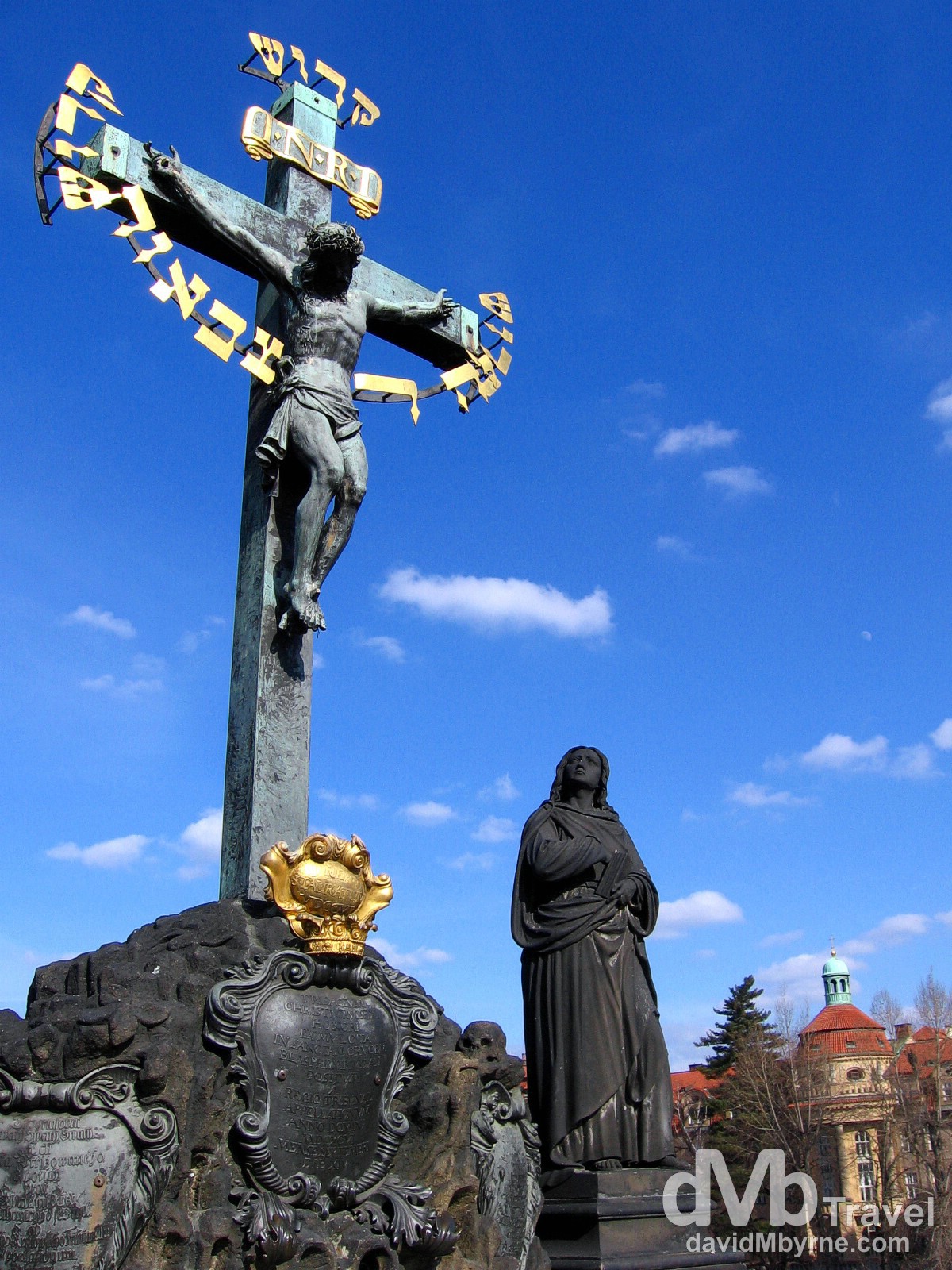
The Charles Bridge balustrades are graced by 30 (mostly Baroque) statues. Erected between 1683 and 1714, the statues depict various Saints and Patron Saints venerated at that time. They were worked on by the most prominent Bohemian sculptors of the time. However, the statues adorning the bridge today are not what they seem. Beginning in 1965 all of the statues were replaced by replicas with the originals on show in the city’s National Museum. Charles Bridge, Prague, Czech Republic. March 8, 2006.
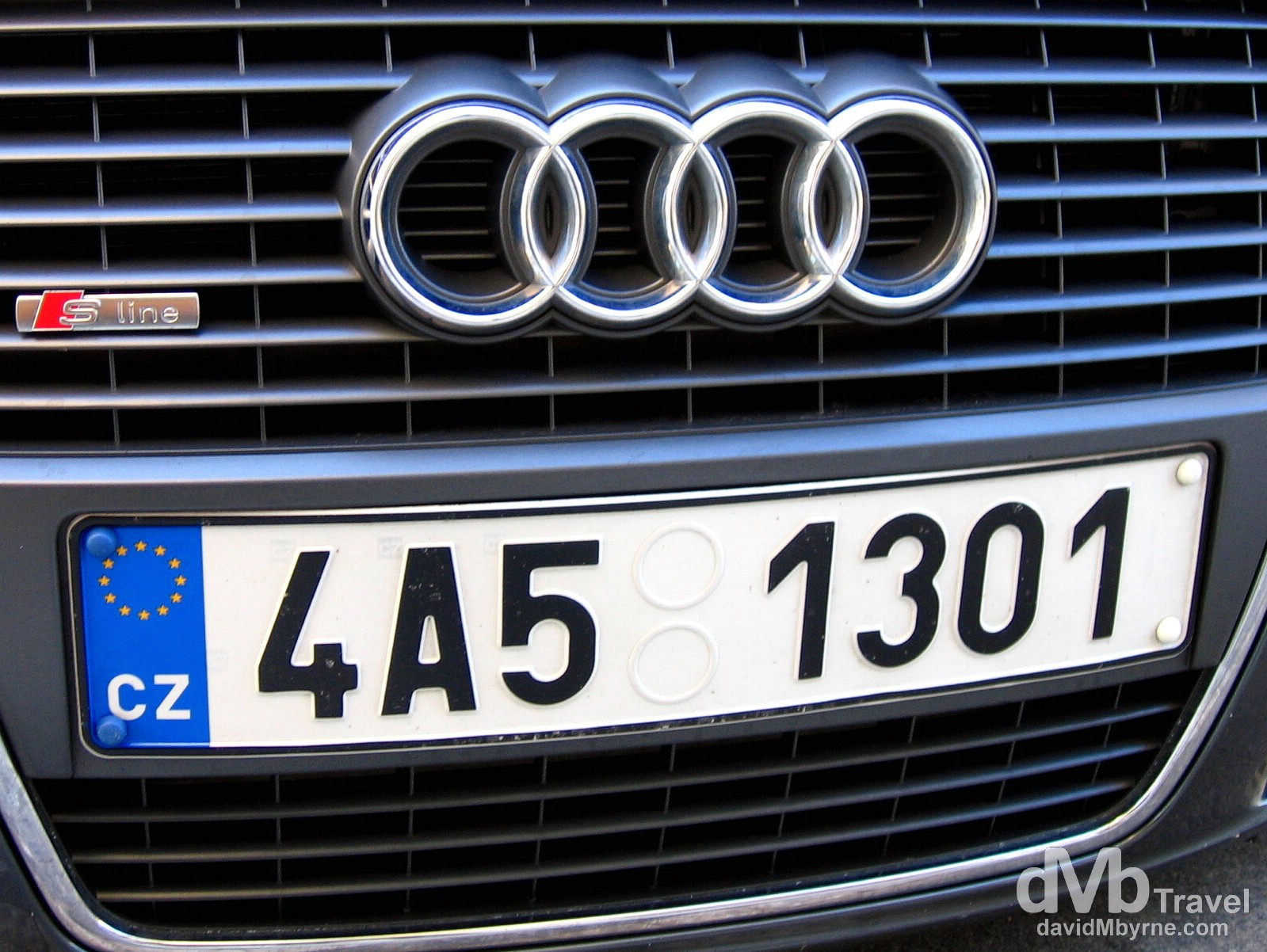
On the streets of Prague, Czech Republic. March 8, 2006.
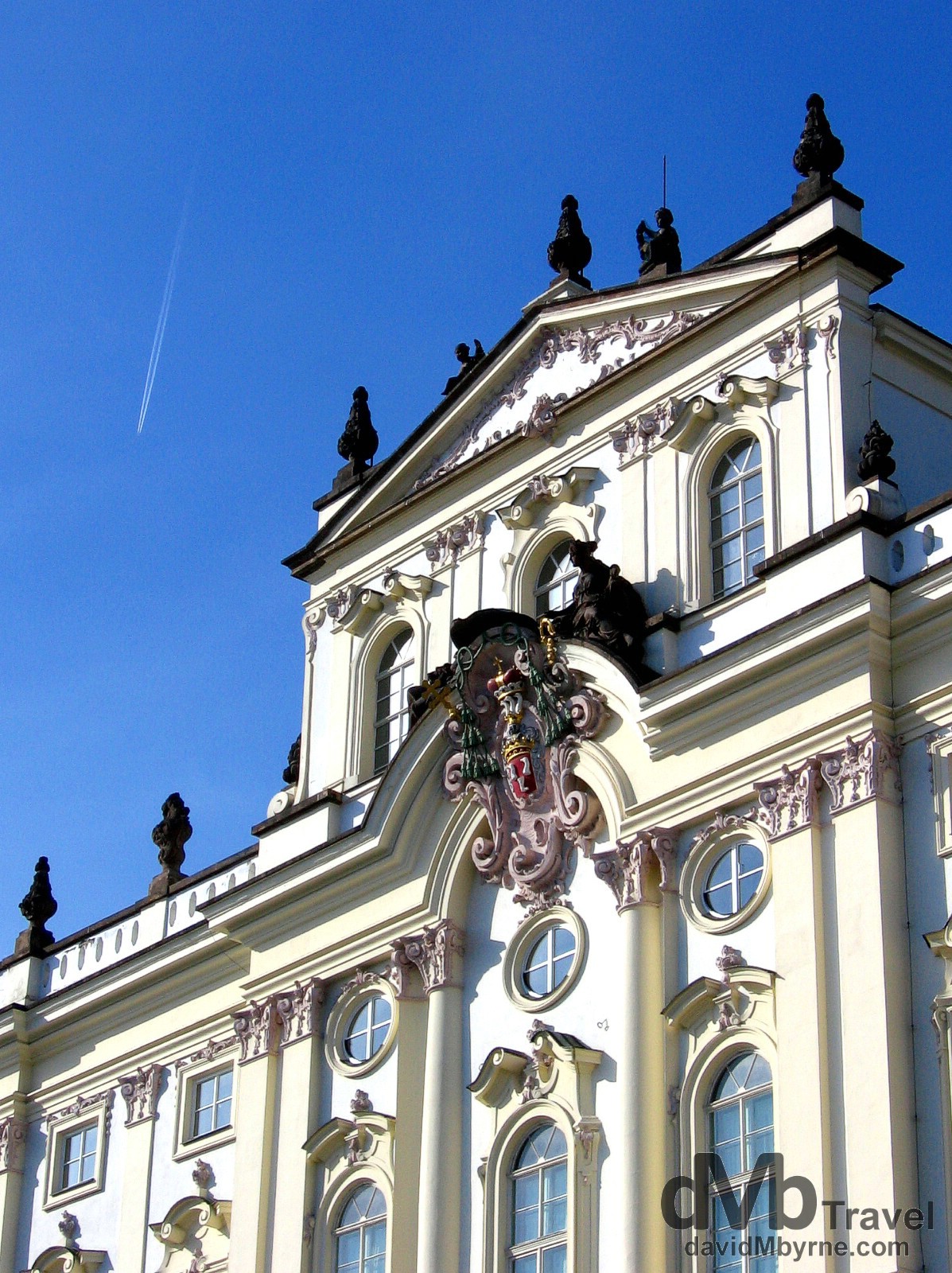
The facade of Prague Castle of the castle complex dominating the hill over the medieval castle district of the city. Visual from virtually every point in the city, this is where the Czech kings, Holy Roman Emperors and presidents of Czechoslovakia & the Czech Republic have had their offices. The crown jewels of the Bohemian Kingdom are kept here. The Castle, measuring 570 meters in length and with an average width of 130 meters, is one of the biggest castles in the world – the Guinness Book of Records has it listed as the biggest ancient castle complex in the world. At the main entrance at the western end of the complex one can witness the ceremonial changing of the castle guard on the hour, every hour, with a band, playing from the windows above the courtyard, accompanying the ceremony daily at noon. The façade of Prague Castle. Prague Castle, Prague Czech Republic. March 8, 2006.
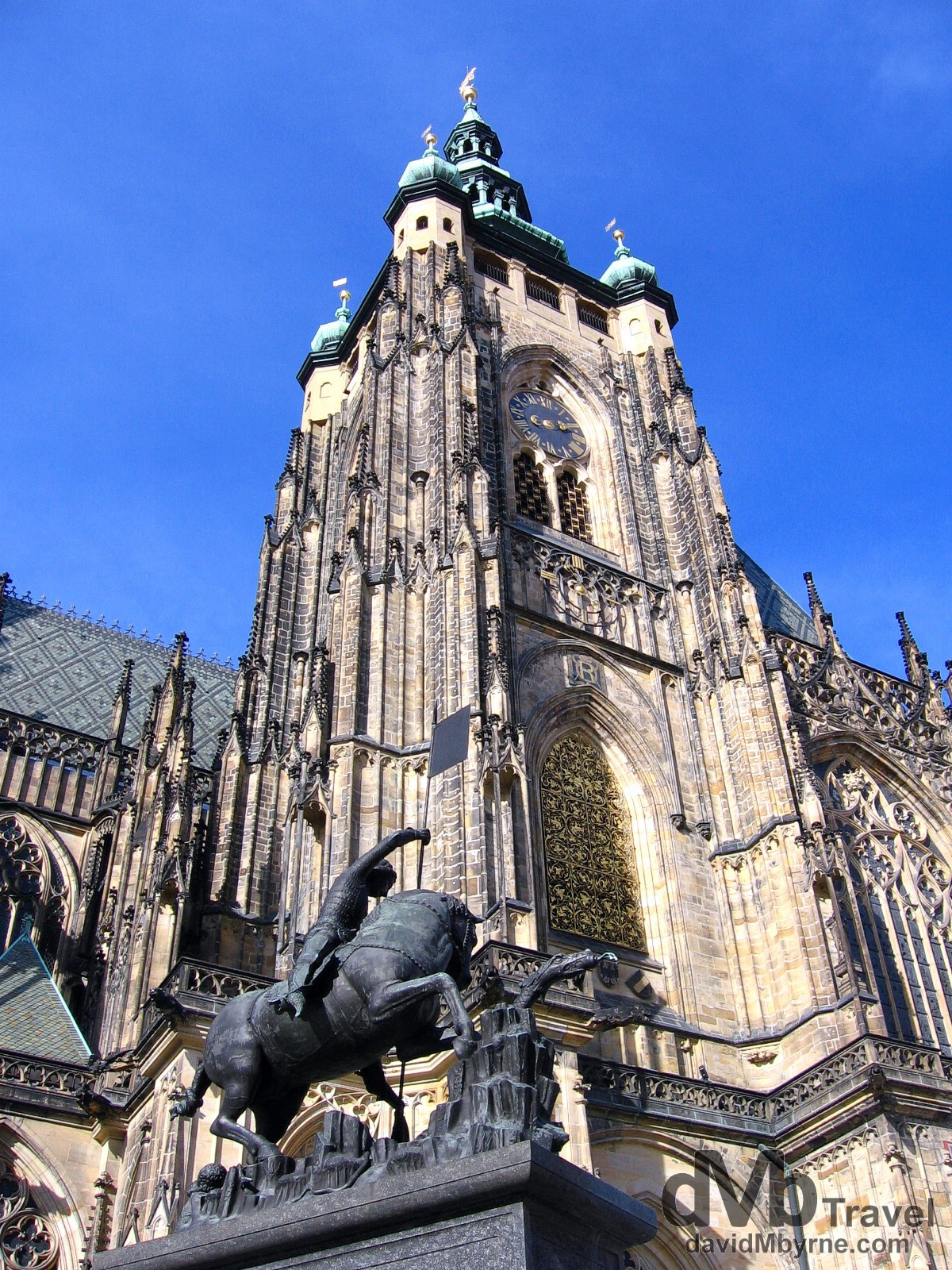
The 3rd courtyard of the Prague Castle complex is dominated by Saint Vitus Cathedral, a glorious and hugely impressive French Gothic structure. Construction began under the order of Emperor Charles IV in 1344 but it wasn’t fully finished until 1929. Union issues no doubt. Its interior houses a wealth of ancient Czech stuff, including tombs and paintings, but I limited myself to admiring the cathedral from the outside. The cathedral is still the seat of the Archbishop of Prague and is still the biggest and most important church in the Czech Republic. Saint Vitus Cathedral, Prague Castle, Prague, Czech Republic. March 8, 2006.
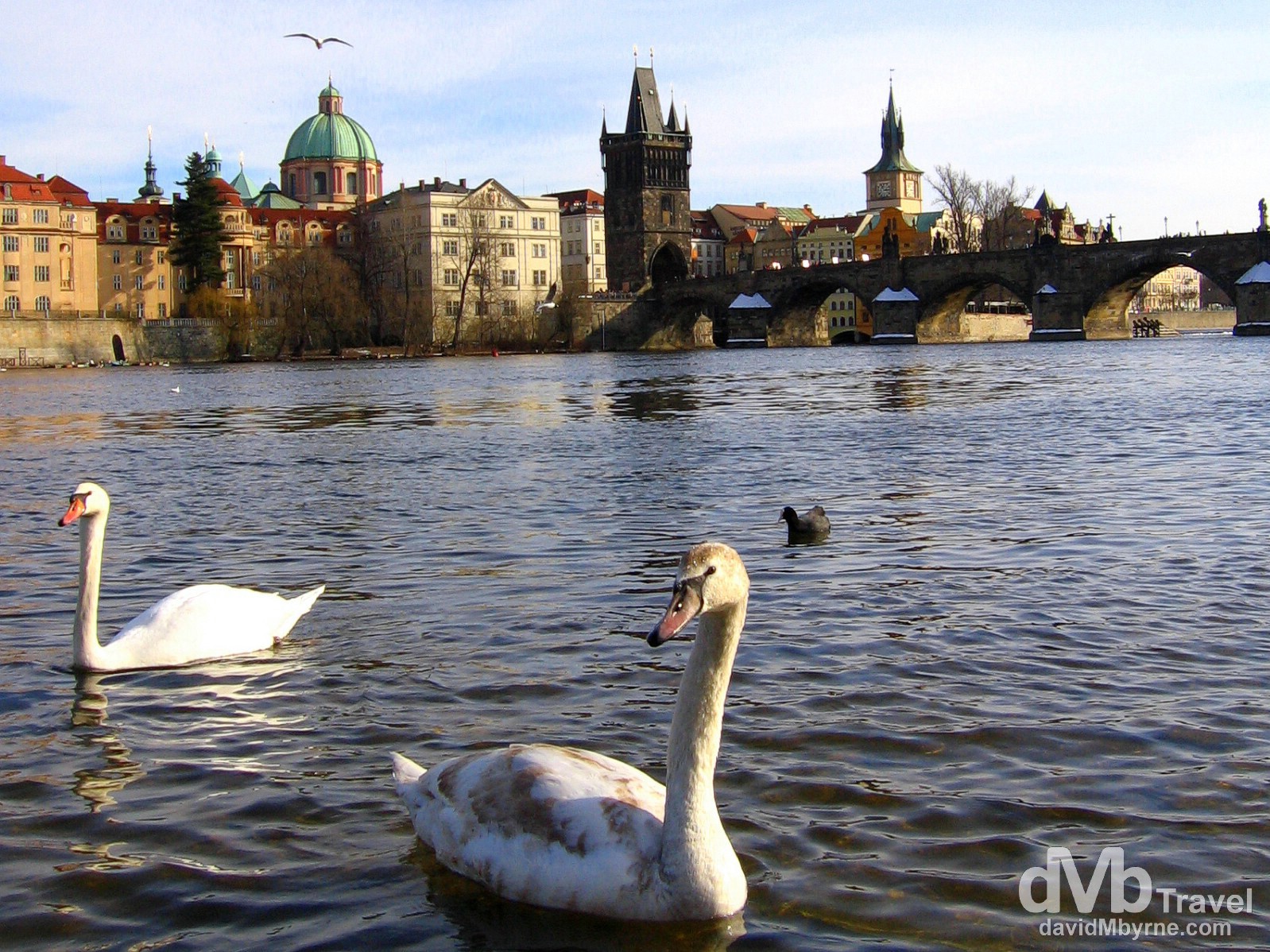
Swans on the west bank of the Vltava River fronting Charles Bridge & the Old Town Bridge Tower in Prague, Czech Republic. March 8, 2006.
